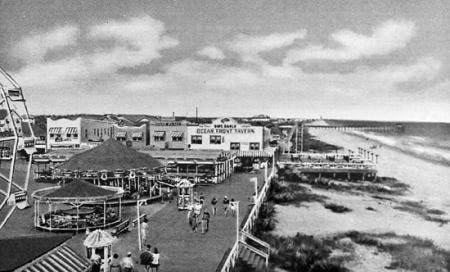From its earliest days as a sleepy logging village and the construction of its first hotel to the closing of the Pavilion and the revitalization of Broadway at the Beach, our area has experienced great change during the past 100+ years.
When the Burroughs and Collins Company of Conway helped build the first railroad line to a village called New Town near the turn of the 20th century, there’s no way anyone could have imagined the area later named Myrtle Beach would grow into one of the premier vacation destinations in the U.S. Exceeding even the wildest expectations for this once humble resort town, Myrtle Beach has expanded outward in every direction addin thousands of high-rise hotels, golf courses, eateries and attractions.
Since having developed a reputation as a place for families throughout the “golden era” of wholesome fun in the 1950s, 60s and 70s, the Grand Strand has spent the past several decades carefully walking the line between the traditions our area is known for and a desire to draw more visitors with bigger, better and newer attractions.
In an effort to pay homage to both the old and new of Myrtle Beach things to do, we’ve created this timeline looking back at the history of the area’s development and tourism. What’s below is by no means an exhaustive exploration of our history, but rather a snapshot collection compiled from a variety of sources of some of the key events, openings and closings that have impacted our beloved beach.
Early History
The first settlers of ‘The Land’
The first recorded history of the Myrtle Beach area begins with Native Americans, who were the first inhabitants of the area now known as Myrtle Beach. These tribes lived in the region for thousands of years prior to the arrival of Europeans and called it “Chicora” meaning “the land”.
1521
About 600 Spanish settlers led by Lucas Vazquez de Ayllon arrived at what is now Hobcaw Barony (just south of Myrtle Beach near Georgetown) with intentions of creating the first permanent settlement in North America. After a few months, the settlement failed and the remaining 150 settlers returned to Hispaniola.
1600
It is estimated that about 900 Native Americans lived in the area. River-dwelling tribes such as the Waccamaw and Winyah inhabited the coast from North Carolina’s Lake Waccamaw to Winyah Bay near Georgetown, S.C. A strong concentration of these tribes lived in the area now known as Dog Bluff, an area of Horry County near Aynor that serves as the tribal grounds for The Waccamaw Indian People of Conway today.
Waccamaw Indians • Source: Waccamaw National Wildlife Refuge
1670
The first permanent settlement in the Carolinas is founded by English settlers in Charles Towne (now Charleston, S.C.). By 1716, an English/Native American trading post en route to Charles Towne was established at Hobcaw Barony.
18th Century
Land grant helps area take shape
Though it now belongs to hundreds and thousands of different private landowners, businesses and corporations, much of the Grand Strand once belonged to a single person ().
In the early 1700s, a landowner named Robert Francis Withers Allston receives a 66,000-acre King’s grant for much of modern Myrtle Beach. Robert and his wife operated a plantation overlooking the tidal creek now known as Withers Swash before he became a state representative and the 67th governor of South Carolina.
1716-1718
With rice and indigo cultivation thriving at plantations across the area and large-scale shipments being traded and delivered by boat, the seas soon became full of pirates. The most famous of these was Edward Teach (a.k.a. Blackbeard) and his 40-gun ship The Queen Anne’s Revenge, which pillaged numerous vessels during “The Golden Age of Piracy” up until Teach’s capture in 1718.
1721
The port city of Georgetown, the southernmost point of the Grand Strand, is founded. It is South Carolina’s third-oldest city.
1740
William Gause, one of the area’s earliest innkeepers opens a tavern for travelers along the old King’s Highway in the Windy Hill area in modern North Myrtle Beach. On his Southern tour in 1791, President George Washington visited the Carolina Coast (), spending time at William Gause’s inn and also stopping to spend the night at Brookgreen Plantation with owner Dr. Henry Collins Flagg and his wife, Rachael Moore Allston.
19th Century
Rice plantations and railroad expansion
During the 1800s, agriculture began to thrive throughout the Grand Strand, with the southern portions — then known as the Georgetown District — becoming prominent rice growing areas. It’s in the later part of the century that the first Eurpoean settlers arrive in the Myrtle Beach area, looking to extend an already-successful system of rice plantations.
1822
A strong hurricane hits the area — then known as Long Bay — and sweeps the house of Robert Francis Withers Allston into the ocean, drowning 18 people inside.
1840
By 1840, the Georgetown District produces nearly half of the total United States’ rice crop () and the City of Georgetown becomes the largest rice-exporting port in the world.
1881
Burroughs & Collins Company of Conway predecessor of modern day Burroughs & Chapin Co. purchases land that would become Myrtle Beach from the Withers family. The area’s first post office, Withers post office, opens seven years later in 1888.
1899
The Burroughs & Collins Company receives a charter to build the Conway Seashore Railroad from the South Carolina General Assembly. The line is completed around the turn of the century connecting Conway to the beach.
Early 20th Century
Railroads and roads pave the way
At the turn of the 20th century, the first trains began running from Conway to New Town on the new Conway & Seashore Railroad. This allowed Burroughs & Collins Co. to transport timber to and from the area near the beach and begin moving away from dealing in timber byproducts such as turpentine which was waning in value.
The line, which helped establish our area as a viable place for industry, was later called the Conway Coast and Western Railroad (1904) and became part of the Atlantic Coast Line Railroad in 1911.
1901
The Seaside Inn, the area’s first hotel, is built. At that time, oceanfront lots sold for $25 (), and buyers received an extra lot if they built a house valued at $500 or more. The hotel is later demolished in the late 1920s.
1907
The Horry Herald sponsors a contest to officially name the New Town area. Mrs. F.E. Burroughs wins the contest with the name “Myrtle Beach,” which she chose for the many wax myrtle trees growing wild along the shore.
1908
The first Myrtle Beach Pavilion is built. It is a one-story wooden structure that was constructed as part of the Seaside Inn property. This structure would later burn to the ground and be replaced by a larger version.
1912
The Burroughs & Collins Company’s beach development efforts are rolled into a new entity called the Myrtle Beach Farms Company.
Even as others such as John T. Woodside and Myrtle Beach Estates began to grab up much of the property around the area, Myrtle Beach Farms retained key portions of downtown about 1,300 acres including the Pavilion area and surrounding beach between Third Avenue North and Ninth Avenue North.
1914
The first road for automobiles, a sand road which runs through the area now known as Socastee, is built between Conway and Myrtle Beach. Later this year, the Town of Aynor in western Horry County is incorporated for the first time.


